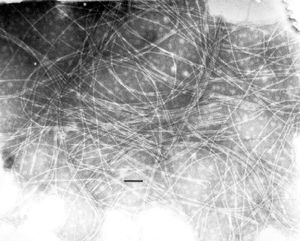Inoviridae: Difference between revisions
From MicrobeWiki, the student-edited microbiology resource
No edit summary |
No edit summary |
||
| Line 1: | Line 1: | ||
[[Image:inoviridae.jpg|thumb|right|(EM of Thermus phage H75, a member of Inoviridae. From [http://www.ncbi.nlm.nih.gov/ICTVdb/Images/Ackerman/Phages/Inovirid/773-08.htm ICTVdB | [[Image:inoviridae.jpg|thumb|right|(EM of Thermus phage H75, a member of Inoviridae. From [http://www.ncbi.nlm.nih.gov/ICTVdb/Images/Ackerman/Phages/Inovirid/773-08.htm ICTVdB-Picture Gallery]; Courtesy Dr. Hans Ackermann]] | ||
==Baltimore Classification== | ==Baltimore Classification== | ||
Revision as of 19:16, 21 June 2006

(EM of Thermus phage H75, a member of Inoviridae. From ICTVdB-Picture Gallery; Courtesy Dr. Hans Ackermann
Baltimore Classification
Higher order taxa
Viruses; ssDNA viruses; Inoviridae
Genera
Inovirus, Plectovirus
Description and Significance
Inoviridae viruses are non-enveloped bacteriophages that infect E. coli by a slow-release life cycle.
Genome Structure
The genome of Inoviridae is not segmented and contains a molecule of circular, positive-sense, single-stranded DNA. The complete genome is 4400-8500 nucleotides long. (source: ICTV dB Descriptions)
Virion Structure of an Inoviridae
The virions of Inoviridae consist of a capsid that is not enveloped. The capsid is elongated and exhibits icosahedral symmetry. The capsid is rod-shaped, straight to flexuous with a length of 85-280 nm or 760-1950 nm, and a width of 10-16 nm or 6-8 nm. Frequently morphologically aberrant forms have also been observed and they are of abnormal length. (source: ICTV dB Descriptions)
